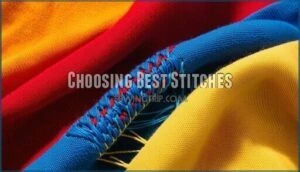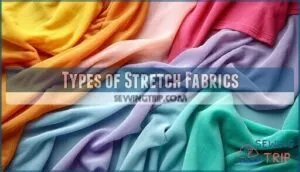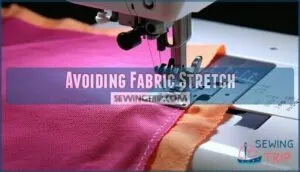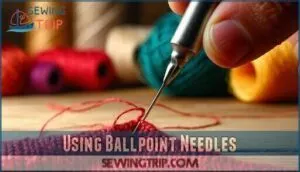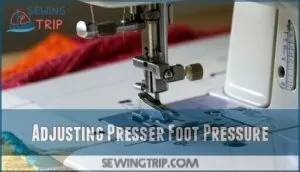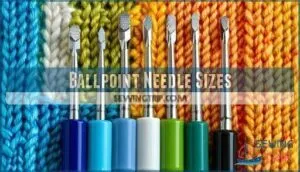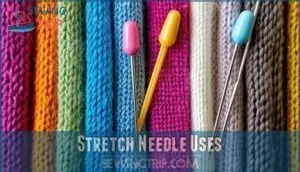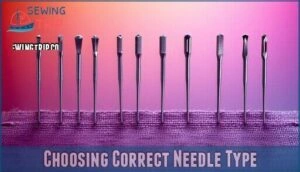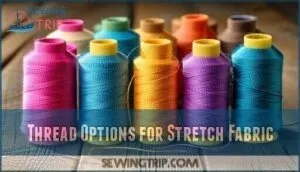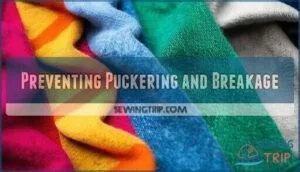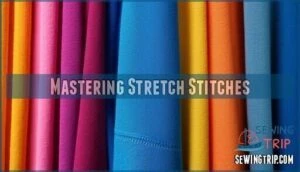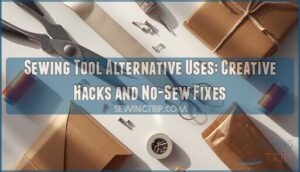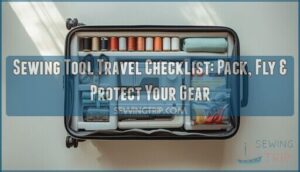This site is supported by our readers. We may earn a commission, at no cost to you, if you purchase through links.

A zigzag stitch is versatile, while a triple zigzag adds extra durability—perfect for high-stress areas.
The lightning bolt stitch, found on many modern machines, mimics a straight stitch but stretches with your fabric.
Always use a ballpoint or stretch needle—it slides between fibers instead of piercing them, reducing skipped stitches.
Don’t forget, polyester or woolly nylon thread works best for flexibility.
Adjust your stitch length and presser foot pressure carefully to avoid puckering or distortion.
Curious about more pro tips?
Stretching those skills starts here.
Table Of Contents
Key Takeaways
- Use a zigzag stitch or triple zigzag for flexible, durable seams that won’t break on stretchy fabrics.
- Always use a ballpoint or stretch needle to avoid skipped stitches and fabric damage.
- Polyester thread works best as it stretches with the fabric, preventing popped seams.
- Adjust stitch length, width, and presser foot pressure to prevent puckering and maintain smooth, flexible results.
Choosing Best Stitches
Choosing the right stitch is vital for keeping stretchy fabrics secure without restricting movement.
With options like zigzag, triple zigzag, and lightning bolt stitches, you can confirm your seams are both flexible and durable.
Zigzag Stitch Benefits
A zigzag stitch is your go-to for sewing stretchy fabric.
It’s beginner-friendly, flexing with every pull. This stitch prevents pops in horizontal seams while allowing the fabric to move naturally.
Perfect for knit fabric stitches, it provides seam flexibility and hem stretching. Most sewing machine stitches include it, making it a versatile option among stretch stitch types.
Triple Zigzag Stitch Uses
Looking to create durable, stretchy seams for heavy knits or projects like outdoor gear and underwear? The triple zigzag stitch is your go-to.
It’s a versatile option among stretch stitch types, offering strength and flexibility. Perfect for sewing stretchy fabric, it excels at:
- Reinforcing seams on knit fabrics.
- Attaching elastic without snapping threads.
- Adding decorative stitches for an extra touch.
For best results, consider using a zigzag presser foot to stabilize the fabric.
Lightning Bolt Stitch Applications
Switching to thicker knit seams or projects needing durability? The lightning bolt stitch is your hero.
This stretch-friendly option elongates under pressure, making it perfect for activewear sewing, durable knitwear, and upholstery projects.
Its zigzag-like pattern flexes with ease, ensuring no popped threads. Use this for thick knit seams, industrial applications, or when sewing stretchy fabrics with professional-grade precision.
Types of Stretch Fabrics
When working with stretch fabrics, it’s helpful to understand the unique characteristics of each type.
From lightweight jersey to durable double knits, knowing what to expect guarantees you can choose the right fabric for your project, and this understanding is crucial for the success of your work with stretch fabrics.
Jersey Fabric Characteristics
Jersey fabric is lightweight, soft, and perfect for sewing stretchy fabric projects.
Its breathability and natural drape make it versatile and comfortable.
Here’s why it works wonders:
- Durability: Stands up to everyday wear.
- Drape: Flows beautifully for shirts or dresses.
- Weight: Easy to handle.
- Cost: Affordable for beginners.
- Breathability: Keeps you cool.
Lycra and Spandex Fabric Uses
Lycra and spandex fabrics shine in activewear, swimwear, and shaping garments due to their exceptional elasticity.
Ideal for compression benefits and costume design, they stretch and recover beautifully.
When sewing stretchy fabric, use the best stitch for lycra, like a zigzag, for durability.
Check this quick guide:
| Application | Benefit | Stitch Recommendation |
|---|---|---|
| Activewear | Flexibility | Zigzag |
| Swimwear | Durability | Triple Zigzag |
| Shaping Garments | Compression & Fit | Stretch Stitch |
Double Knit Fabric Properties
Double knit is a versatile, medium-weight fabric with unique benefits.
Its balanced structure guarantees great drape quality and wrinkle resistance, making it popular for everyday wear.
Weft knits offer elasticity, making them ideal for stretchy garments.
- Fabric weight: Medium, ideal for leggings and skirts.
- Thermal properties: Keeps you warm without bulk.
- Care instructions: Wash gently to avoid stretching or fading.
- Stretch fabric techniques: Works well with knit fabric stitches for durability.
Sewing Techniques for Stretch
When working with stretchy fabrics, it’s vital to use techniques that prevent puckering and maintain flexibility.
From selecting the right needle to adjusting presser foot pressure, small adjustments can make a big difference in achieving professional results, and following these steps can help ensure flexibility is maintained.
Avoiding Fabric Stretch
Before sewing stretchy fabric, always pre-wash to prevent shrinkage and avoid puckering later.
Use a wide cutting space to keep the knit fabric relaxed. Stabilizers can prevent unwanted movement, and a walking foot guarantees even feeding.
Keep the needle down if pausing to avoid skipped stitches. These stretch fabric techniques help maintain your garment’s shape beautifully.
Using Ballpoint Needles
A ballpoint needle is your best friend when sewing stretchy fabric.
It extends needle lifespan, handles stretch fabric gracefully, and substantially improves your sewing experience.
Unlike standard sewing machine needles, its rounded tip prevents fabric piercing in a harsh way, gliding between knit fabric fibers without causing runs.
Opt for sizes 70-120, depending on the material.
For best results, remember to check stretch percentages to match the fabric to your project and ensure a smooth sewing experience with the right needle size for your stretch fabric and to get the best out of your ballpoint needle.
Adjusting Presser Foot Pressure
When your fabric feed feels uneven or seams don’t align, tweak your sewing machine’s pressure settings.
Adjusting the presser foot releases tension balance, smoothing thick or stretchy fabrics without puckering.
Too much pressure risks damage, so lower it for stretch fabrics.
Pair with foot compatibility tools and proper thread tension to keep stitches even and your sewing frustration-free.
Best Needles for Stretchy Fabric
Using the right needle makes all the difference when sewing stretchy fabrics. Ballpoint and stretch needles are designed to glide through the fibers without causing snags or skipped stitches.
Ballpoint Needle Sizes
Picking the correct ballpoint needle size matters when sewing stretchy fabric.
Use a Needle Size Guide to match fabric weight precisely—lightweight knits need size 70-80, while thicker materials suit 90-100.
This rounded Needle Point Type glides between fibers, Preventing Fabric Damage.
Understanding available needle sizes is vital for achieving the best results.
It’s a great Universal Needle Alternative, ensuring smoother stitches without snagging delicate fabrics or compromising stretchability.
Stretch Needle Uses
Stretch needles are essential for sewing stretchy fabric seamlessly, preventing skipped stitches and fabric damage.
Their rounded tip glides between fibers instead of piercing them.
Here’s how they shine:
- Ideal for knit fabric sewing, ensuring smooth seams.
- Works with stretchy threads for ultimate thread compatibility.
- Prevents skipped stitches for professional results.
- Great for delicate fabrics, avoiding snags.
You can find various specialty sewing products online.
Choosing Correct Needle Type
Choosing the right sewing needle is like using the perfect tool for the job—it makes all the difference.
A ballpoint needle gently glides through fibers, preventing skipped stitches. Stretch needles are ideal for knits, avoiding snags.
Selecting the right needle often depends on specific needle dimensions for the task.
Consult this needle size guide for clarity:
| Needle Point Types | Needle Size Guide | Universal Needle Alternative |
|---|---|---|
| Ballpoint | 70-100 | General sewing tasks |
| Stretch | 75-90 | Best for stretchy fabrics |
| Universal | 80-100 | Acceptable for light knits |
The guide provides essential information to ensure you are using the right needle for your sewing project, making it easier to achieve professional results with minimal effort and maximum precision.
Thread Options for Stretch Fabric
Choosing the right thread for stretch fabrics is just as important as selecting the perfect stitch.
Polyester and woolly nylon threads are great options because they stretch with your fabric, preventing popped seams.
Polyester Thread Benefits
Polyester thread is your go-to for sewing stretchy fabric.
Its durability guarantees lasting seams, while its cost-effectiveness makes it a favorite.
Polyester’s color retention keeps projects vibrant, even after many washes.
Reduced puckering improves your finish, and its stretch thread design pairs perfectly with a stretch stitch for added seam strength and flexibility.
It’s the ideal choice for stretch sewing.
Woolly Nylon Thread Uses
Woolly nylon thread is a game-changer for sewing stretchy fabric.
Woolly nylon thread ensures smooth, elastic seams, making it the ultimate choice for professional, long-lasting results with stretchy fabrics.
Its stretch thread design guarantees seam flexibility and thread durability, ideal for delicate knits.
The softness prevents puckering, while elasticity stabilizes buttonholes.
Perfect with zigzag or serger stitches, it balances tension flawlessly.
Use it for hems or elastic sewing, guaranteeing professional, long-lasting results in all stretchy projects with perfect outcomes.
Thread Tension Adjustment
Balanced tension is key for smooth stitches.
Adjust your sewing machine settings based on fabric thickness and thread type. Test stitching first lets you troubleshoot tension issues.
For stretch fabric, slightly loosen thread tension to prevent puckering. Combine this with proper sewing techniques, and you’ll nail professional seams that flex perfectly without breaking.
Practice makes mastery!
Preventing Puckering and Breakage
To prevent puckering and breakage when sewing stretchy fabrics, focus on choosing the right stitch and adjusting your sewing machine settings.
Techniques like using a zigzag stitch, twin needle, or cover stitch machine guarantee your seams stay smooth and durable.
Using Zigzag Stitch
A zigzag stitch is your go-to for stretchy fabric.
Adjust the zigzag width and length for perfect seam flexibility—try 2-2.5 width and 1.6 length for horizontal seams.
Its stitch density handles hemming knits smoothly, flexing with the fabric.
This simple, versatile stitch guarantees your knit fabric sewing stays strong without breaking, making it a favorite among sewing techniques for stretchy fabrics.
Twin Needle Stitch Benefits
Using a twin needle stitch on your sewing machine adds both function and flair to stretch fabric projects.
It enhances hem durability, creates parallel seams for a polished look, and offers aesthetic appeal with decorative stitching.
Perfect for knit fabric sewing, it’s ideal for knit applications requiring flexibility and elegance.
Master this technique for professional, stretch-friendly results.
Cover Stitch Machine Uses
A cover stitch machine is a game-changer for stretchy fabric.
It’s your go-to for hemming knits, chain stitching, and seamless seam finishing.
Whether binding edges or tackling decorative applications, it creates strong, flexible stitches.
Unlike a regular sewing machine, its professional touch handles knit fabric perfectly, saving time while ensuring durable, smooth hems on activewear and everyday garments.
Many users find the differential feed invaluable for preventing wavy hems.
This feature is particularly useful, making the cover stitch machine a valuable tool for working with stretchy fabrics, providing a professional touch and ensuring durable results.
Mastering Stretch Stitches
Stretch stitches let your seams move without breaking, making them essential for stretchy fabrics.
By learning techniques like the step zigzag and triple straight stitch, you can create flexible, durable finishes with ease.
Step Zigzag Stitch Technique
Mastering the step zigzag stitch technique guarantees neat seams on stretchy fabric.
Start by setting a narrow zigzag stitch—adjust stitch width settings to 2 and length around 1.6.
Keep tension balance tips in mind to avoid puckering, and remember that fabric stabilization helps prevent distortion during sewing.
Ideal for seam finishing, this sewing machine stitch pattern keeps your edges stretchy and durable.
Triple Straight Stitch Applications
When working with stretchy fabric, the triple straight stitch offers incredible seam durability.
It reinforces stitching by moving two steps forward and one back, delivering strength that handles heavy knits and upholstery seams.
Perfect for stress points in athletic wear, it guarantees seams stretch without snapping.
Use it for top-stitching or constructing garments that need reliability and flexibility.
Adjusting Stitch Length and Width
Don’t overlook the magic of sewing machine stitch adjustments. Finding the ideal length and perfect width guarantees flexibility and strength.
Start with fabric testing to test tension balance. For stretchy fabric, shorter stitch lengths create higher stitch density, while wider stitch widths prevent popping.
Adjust your sewing machine stitch selection thoughtfully—every fabric behaves differently, so let testing guide you!
Frequently Asked Questions (FAQs)
What is the best stitch for stretchy fabric?
The zigzag stitch is your best bet for stretchy fabrics.
Its flexibility lets seams stretch without breaking.
You can also try a triple zigzag or stretch stitch for added durability on thicker knits.
What is the brother stitch for stretchy fabric?
The best Brother stitch for stretchy fabric is the zigzag stitch.
It’s flexible, lets seams stretch with the fabric, and avoids thread popping.
Adjust the width (2-5) and length (6) for smooth results.
Can you sew stretchy fabric with a straight stitch?
Think you can sew stretchy fabric with a straight stitch?
You can, but it’s tricky.
Use the stretch straight stitch setting if your machine has one, or keep stitching loose to avoid popped seams.
How to finish raw edges on stretchy fabric?
To finish raw edges on stretchy fabric, use an overlock stitch or a zigzag stitch.
Both prevent fraying and maintain stretch.
If using a standard machine, stabilize the fabric or use stretchable threads for durability.
Can stretchy fabrics be hemmed without special machines?
Yes, you can hem stretchy fabrics with a regular sewing machine.
Use a ballpoint needle, polyester thread, and a narrow zigzag stitch.
Stabilize the fabric with tape, and let the machine guide the stretch.
How to reinforce stretchy fabric seams for durability?
To make stretchy fabric seams more durable, use a zigzag or triple straight stitch.
Pair them with polyester thread and a ballpoint needle.
Test on scraps first, avoid stretching, and consider stabilizers for extra reinforcement.
What is the best method to sew buttonholes on stretch fabrics?
Use a ballpoint needle to avoid tearing fibers, and stabilize the fabric with fusible interfacing.
Sew buttonholes in the fabric’s least-stretchy direction, ensuring your stitches are flexible to handle movement without breaking.
How to prevent curling edges on stretchy knit fabrics?
To prevent curling edges on stretchy knit fabrics, stabilize them with starch spray or fusible interfacing.
Use a walking foot when sewing, keep the fabric flat, and handle it gently to avoid distortion.
Conclusion
Just like a needle threading through fabric, mastering the best stitches for stretchy fabric weaves skill and confidence into your sewing projects.
By choosing the right stitches—zigzag, triple zigzag, or lightning bolt—and pairing them with proper needles and threads, you’ll guarantee every seam stretches without breaking.
Remember to adjust your machine settings to suit the fabric, and don’t rush the process, to sew successfully with confidence. With these tips, you’re ready to tackle stretchy materials like a true pro.

